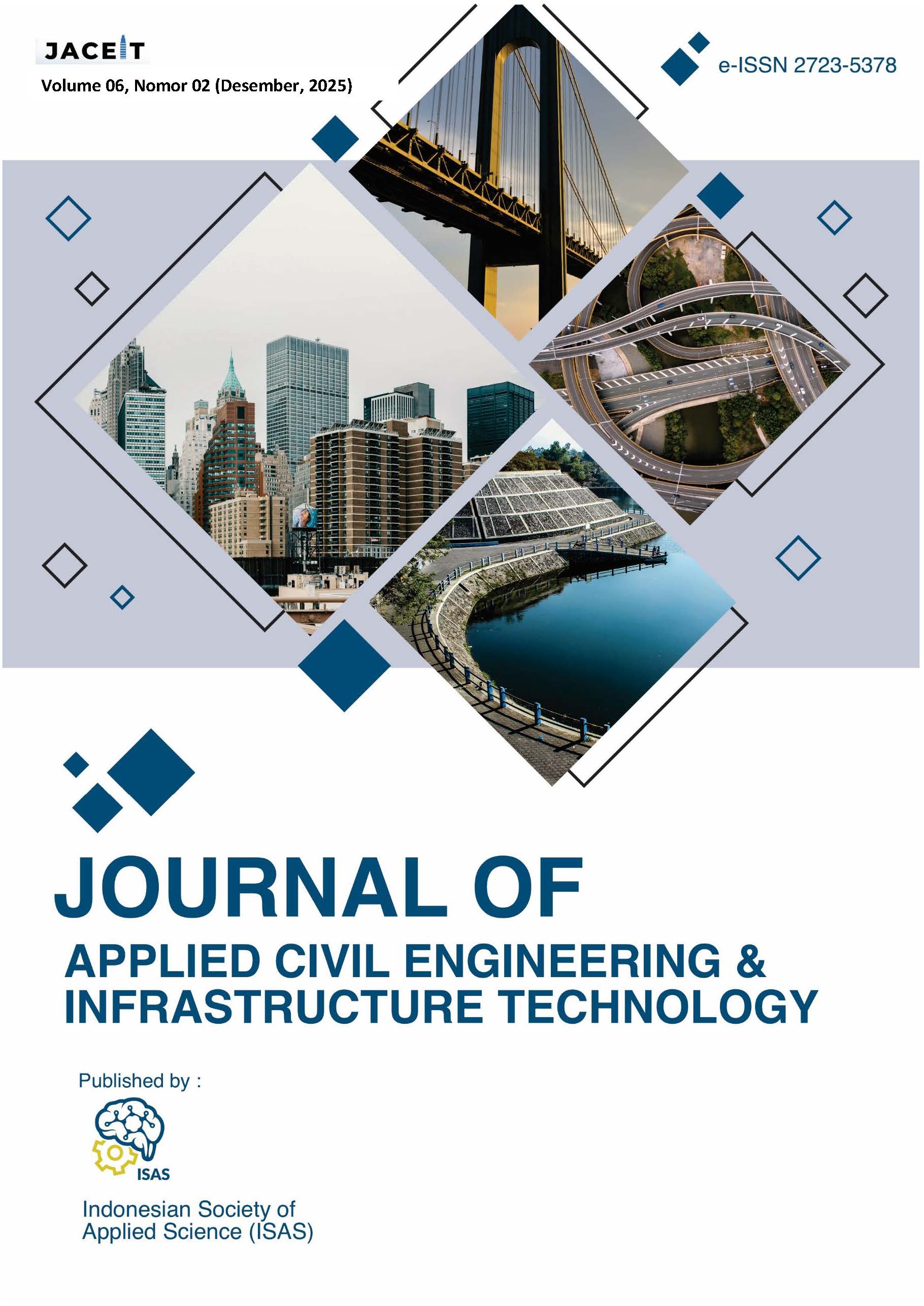Pengaruh Penambahan Fly Ash Terhadap Nilai Koefisien Permeabilitas Tanah Lempung Organik
DOI:
https://doi.org/10.52158/jaceit.v6i2.1005Keywords:
Soil Stabilization, Fly Ash, PermeabilityAbstract
The role of soil is very crucial and is always closely related to infrastructure development. This is because soil functions as the basis for building construction, serving to receive and support the structural loads placed on it. In high rainfall weather conditions, the surface of the slope is susceptible to landslides. Landslides occur due to excessive water infiltration, causing the soil to become weak and collapse. To prevent landslides, efforts need to be made to reduce soil infiltration or permeability. The purpose of this study was to determine the characteristics of the addition of Fly Ash to the permeability of organic clay soil and to determine the optimum composition of the addition of Fly Ash to reduce the permeability coefficient value. The addition of variations in the percentage of Fly Ash was 8%, 16%, and 24% with a curing period of 3 days, 14 days, and 28 days. The test results obtained with the addition of 24% Fly Ash resulted in a decrease in the permeability coefficient value of 84.08% against untreated soil. It can be concluded that the use of Fly Ash can be used as a soil stabilization material, especially in permeability testing.
References
N. A. Arinda Leliana, “Pengaruh Penambahan Fly Ash Terhadap Nilai Kuat Tekan Bebas Pada Tanah Lempung Ekspansif Di Daerah Magetan Jawa Timur,” Rekayasa Teknik Sipil, vol. 1, pp. 1–8, 2015, Accessed: Aug. 02, 2024. [Online]. Available: https://ejournal.unesa.ac.id/index.php/rekayasa-teknik-sipil/article/view/10064
A.S. Budiharso, C. Kasenda, “Analisis Tingkat Kerawanan Pergerakan Tanah Di Kelurahan Taas Kecamatan Tikala Kota Manado, Sulawesi Utara,” Journal Geological Processes, Risks and Integrated Spatial Modeling, vol. 02, 2024, Accessed: Aug. 01, 2024. [Online]. Available: https://www.jurnal.prisma.ac.id/index.php/jgprism/article/view/147/42
J. Dungca, J. Galupino, E. Joenel, G. Galupino, and J. R. Dungca, “Permeability characteristics of soil-fly ash mix,” Article in ARPN Journal of Engineering and Applied Sciences, vol. 10, no. 15, 2015, [Online]. Available: www.arpnjournals.com
J. R. Dungca, W. D. T. Lao, M. Lim, W. D. Lu, and J. C. P. Redelicia, “Vertical permeability of dredged soil stabilized with fly-ash based geopolymer for road embankment,” International Journal of GEOMATE, vol. 17, no. 59, pp. 8–14, 2019, doi: 10.21660/2019.59.4525.
E. E. Hangge, R. A. Bella, and M. C. Ullu, “Pemanfaatan Fly Ash Untuk Stabilisasi Tanah Dasar Lempung Ekspansif,” 2021. Accessed: Aug. 02, 2024. [Online]. Available: https://sipil.ejournal.web.id/index.php/jts/article/view/397
Hardiyatmo, “Analisis Kuat Tekan Bebas Pada Pebambahan Matos Terhadap Stabilisasi Tanah Lempung Dengan Semen,” MEDIA ILMIAH TEKNIK SIPIL, vol. 5, pp. 30–39, 2016, [Online]. Available: https://journal.umpr.ac.id/index.php/mits/article/view/328
M. Li, H. Li, Y. U. He-Miao, B.-H. Zhao, and Z.-X. Qi, “Discussion on permeability characteristics of lime and fly ash solidified petroleum-contaminated soil and its engineering reuse,” Rock and Soil Mechanics 2023, vol. 45, no. 1, pp. 108–116, doi: 10.16285/j.rsm.2023.5059.
V. Nadia Lonarissa Harditya Putri and B. Karsono, “The Effect Of Limestone and Fly on Clay Stabilization of CBR and Soil Compressive Strength,” International Journal of Engineering, Science & InformationTechnology (IJESTY), vol. 2, 2022, doi: 10.52088/ijesty.v1i1.251.
S. Shil, S. Kumar Pal, and A. Prof, “Permeability and Volume Change Behaviour of Soil Stabilized with Fly ash.” [Online]. Available: www.ijert.org
R. Tarigan, Parman, and M. A. S. Harahap, “Study of Residual Soil Permeability Coefficient Post Addition of Coal Fly Ash,” International Journal of Research in Vocational Studies (IJRVOCAS), vol. 3, no. 4, pp. 159–164, Jan. 2024, doi: 10.53893/ijrvocas.v3i4.103.
Muh. Ariawan Suriyadi, “Pengaruh Kadar Bitumen Asbuton Terhadap Kuat Tekan Bebas Dan Permeabilitas Tanah Lempung Dengan Variasi Pemeraman.,” 2019, Accessed: Jul. 11, 2024. [Online]. Available: https://repository.unibos.ac.id/xmlui/handle/123456789/4013
G. Y. S. R. Ali Zakariya1, “Potensi Pemanfaatan Fly Ash Dalam Pembangunan Konstruksi Jalan dan Jembatan Untuk Mewujudkan Infrastruktur Berkelanjutan Di Indonesia,” Jurnal Infrastruktur, vol. 08, 2022, Accessed: Jul. 11, 2024. [Online]. Available: https://www.researchgate.net/publication/362708602_Potensi_Pemanfaatan_Fly_Ash_Dalam_Pembangunan_Konstruksi_Jalan_dan_Jembatan_untuk_Mewujudkan_Infrastruktur_Berkelanjutan_di_Indonesia



